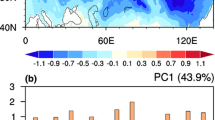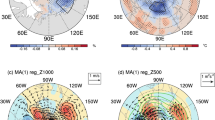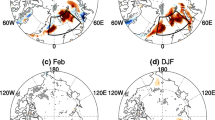Abstract
Previous study indicated that changes in the Arctic sea ice concentration (ASIC) during boreal autumn in the Laptev-eastern Siberian-Beaufort Seas have a marked influence on the interannual variation of Arctic oscillation (AO) during following spring. This study reveals a pronounced enhancement of the linkage between autumn ASIC changes and following spring AO since the mid-1990s. The correlation coefficient between the autumn ASIC and spring AO index reaches 0.72 during 1998–2014. During this period, autumn ASIC decrease results in pronounced tropospheric warming over the high latitudes and a reduction of meridional temperature gradient. This leads to decrease in circumpolar westerly winds and increase in the upward propagation of quasi-stationary wave, which weakens stratospheric polar vortex. Then, spring AO becomes weaker than normal via the interaction between stationary wave and mean flow and the accompanying downward propagation of anomalous easterly winds. Before the mid-1990s, however, decrease in the autumn ASIC is not followed by an obvious change in the overlying air temperature. Accordingly, circumpolar westerly winds and polar vortex experience weak changes. Thus, the linkage between the autumn ASIC and following spring AO is weak. It is suggested that interdecadal change in the impact of autumn ASIC on the spring AO is attributed to a change in the interannual variability of autumn ASIC. Specifically, interannual variability of autumn ASIC is much larger after the mid-1990s, which contributes to stronger stratospheric response and ASIC-spring AO connection.















Similar content being viewed by others
References
Andrews DG, Holton JR, Leovy CB (1987) Middle atmosphere dynamics. Academic Press, Dublin
Baldwin MP, Dunkerton TJ (1999) Downward propagation of the Arctic oscillation from the stratosphere to the troposphere. J Geophys Res 104(30):937–946. https://doi.org/10.1029/1999JD900445
Baldwin MP, Dunkerton TJ (2001) Stratospheric harbingers of anomalous weather regimes. Science 294:581–584. https://doi.org/10.1126/science.1063315
Bintanja R, Graversen RG, Hazeleger W (2011) Arctic winter warming amplified by the thermal inversions and consequent low infrared cooling to space. Nat Geosci 4:758–761. https://doi.org/10.1038/ngeo1285
Charney JG, Drazin G (1961) Propagation of planetary-scale disturbances from the lower into the upper atmosphere. J Geophys Res 66:83–109. https://doi.org/10.1029/JZ066i001p00083
Chen S, Song L (2019) The leading interannual variability modes of winter surface air temperature over Southeast Asia. Clim Dyn 52:4715–4734. https://doi.org/10.1007/s00382-018-4406-x
Chen S, Wu R (2018) Impacts of early autumn Arctic sea ice concentration on subsequent spring Eurasian surface air temperature variations. Clim Dyn 51:2523–2542. https://doi.org/10.1007/s00382-017-4026-x
Chen W, Graf HF, Takahashi M (2002) Observed interannual oscillations of planetary wave forcing in the Northern Hemisphere winter. Geophys Res Lett 29:2073. https://doi.org/10.1029/2002GL016062
Chen W, Takahashi M, Graf HF (2003) Interannual variations of stationary planetary wave activity in the northern winter troposphere and stratosphere and their relations to NAM and SST. J Geophys Res 108:4797. https://doi.org/10.1029/2003JD003834
Chen W, Yang S, Huang RH (2005) Relationship between stationary planetary wave activity and the East Asian winter monsoon. J Geophys Res 110:D14110. https://doi.org/10.1029/2004JD005669
Chen S, Yu B, Chen W (2014) An analysis on the physical process of the influence of AO on ENSO. Clim Dyn 42:973–989. https://doi.org/10.1007/s00382-012-1654-z
Chen S, Yu B, Chen W (2015) An interdecadal change in the influence of the spring Arctic oscillation on the subsequent ENSO around the early 1970s. Clim Dyn 44:1109–1126. https://doi.org/10.1007/s00382-014-2152-2
Chen S, Wu R, Liu Y (2016a) Dominant modes of interannual variability in Eurasian surface air temperature during boreal spring. J Clim 29:1109–1125. https://doi.org/10.1175/JCLI-D-15-0524.1
Chen S, Wu R, Chen W, Yu B, Cao X (2016b) Genesis of westerly wind bursts over the equatorial western Pacific during the onset of the strong 2015–16 El Niño. Atmos Sci Lett 17:384–391. https://doi.org/10.1002/asl.669
Chen S, Wu R, Song L, Chen W (2018a) Combined influence of the Arctic oscillation and the Scandinavia pattern on spring surface air temperature variations over Eurasia. J Geophys Res 123:9410–9429. https://doi.org/10.1029/2018JD028685
Chen S, Wu R, Chen W (2018b) A strengthened impact of November Arctic oscillation on subsequent tropical Pacific sea surface temperature variation since the late-1970s. Clim Dyn 51:511–529. https://doi.org/10.1007/s00382-017-3937-x
Chen S, Wu R, Song L, Chen W (2019a) Interannual variability of surface air temperature over mid-high latitudes of Eurasia during boreal autumn. Clim Dyn. https://doi.org/10.1007/s00382-019-04738-9
Chen S, Wu R, Song L, Chen W (2019b) Present-day status and future projection of spring Eurasian surface air temperature in CMIP5 model simulations. Clim Dyn 52:5431. https://doi.org/10.1007/s00382-018-4463-1
Cheung HN, Zhou W, Mok HY, Wu MC (2012) Relationship between Ural-Siberian blocking and East Asian winter monsoon in relation to Arctic oscillation and El Niño/Southern Oscillation. J Clim 25:4242–4257. https://doi.org/10.1175/JCLI-D-11-00225.1
Choi KS, Wu CC, Byun HR (2012) Possible connection between summer tropical cyclone frequency and spring Arctic oscillation over East Asia. Clim Dyn 38:2613–2629. https://doi.org/10.1007/s00382-011-1088-z
Christiansen B (2001) Downward propagation of zonal mean zonal wind anomalies from the stratosphere to the troposphere: model and reanalysis. J Geophys Res 106(D21):307–322. https://doi.org/10.1029/2000JD000214
Cohen J, Fletcher C (2007) Improved skill of Northern Hemisphere winter surface temperature predictions based on land-atmosphere fall anomalies. J Clim 20(16):4118–4132. https://doi.org/10.1175/JCLI4241.1
Cohen J et al (2014) Recent Arctic amplification and extreme mid-latitude weather. Nat Geosci 7:627–637. https://doi.org/10.1038/ngeo2234
Crook JA, Forster PM, Stuber N (2011) Spatial patterns of modeled climate feedback and contributions to temperature response and polar amplification. J Clim 24:3575–3592. https://doi.org/10.1175/2011JCLI3863.1
Dai AG, Luo DH, Song MR, Liu JP (2019) Arctic amplification is caused by sea-ice loss under increasing CO2. Nat Commun 10:121. https://doi.org/10.1038/s41467-018-07954-9
Dee DP et al (2011) The ERA-Interim reanalysis: configuration and performance of the data assimilation system. Q J R Meteorol Soc 137:553–597. https://doi.org/10.1002/qj.828
Deser C, Tomas R, Peng S (2007) The transient atmospheric circulation response to North Atlantic SST and sea ice anomalies. J Clim 20:4751–4767. https://doi.org/10.1175/JCLI4278.1
Deser C, Tomas R, Alexander M, Lawrence D (2010) The seasonal atmospheric response to projected Arctic sea ice loss in the late twenty-first century. J Clim 23:333–351. https://doi.org/10.1175/2009JCLI3053.1
Duchon CE (1979) Lanczos filtering in one and two Dimensions. J Appl Meteorol 18:1016–1022. https://doi.org/10.1175/1520-0450(1979)018%3c1016:LFIOAT%3e2.0.CO;2
Edmon H, Hoskins BJ, McIntyre ME (1980) Eliassen-Palm cross sections for the troposphere. J Atmos Sci 37:2600–2616. https://doi.org/10.1175/1520-0469(1980)037%3c2600:EPCSFT%3e2.0.CO;2
Gao MN, Yang J, Gong DY, Kim SJ (2014) Unstable relationship between spring Arctic oscillation and East Asian summer monsoon. Int J Climatol 34:2522–2528. https://doi.org/10.1002/joc.3849
Gong DY, Wang SW, Zhu JH (2001) East Asian winter monsoon and Arctic oscillation. Geophys Res Lett 28:2073–2076. https://doi.org/10.1029/2000GL012311
Gong DY, Yang J, Kim SJ, Gao YQ, Guo D, Zhou TJ, Hu M (2011) Spring Arctic Oscillation-East Asian summer monsoon connection through circulation changes over the western North Pacific. Clim Dyn 37:2199–2216. https://doi.org/10.1007/s00382-011-1041-1
Hall N, Derome J, Lin H (2001) The extratropical signal generated by a midlatitude SST anomaly. Part I: sensitivity at equilibrium. J Clim 14:2035–2053. https://doi.org/10.1175/1520-0442(2001)014%3c2035:TESGBA%3e2.0.CO;2
Hardiman SC, Kushner PJ, Cohen J (2008) Investigating the ability of general circulation models to capture the effects of Eurasian snow cover on winter climate. J Geophys Res 113:D21123. https://doi.org/10.1029/2008JD010623
Holton JR (2004) An introduction to dynamic meteorology, 4th edn. Academic Press, Dublin
Hu M, Gong DY, Mao R (2013) Possible influence of February–April Arctic oscillation on the ITCZ activity of western-central Pacific. J Trop Meteorol 29:55–65 (Chinese)
Jaiser R, Dethloff K, Handorf D, Rinke A, Cohen J (2012) Impact of sea ice cover changes on the Northern Hemisphere atmospheric winter circulation. Tellus A 64(11):595. https://doi.org/10.3402/tellusa.v64i0.11595
Jeong JH, Ho CH (2005) Changes in occurrence of cold surges over east Asia in association with Arctic Oscillation. Geophys Res Lett 32:L14704. https://doi.org/10.1029/2005GL023024
Jia XJ, Lin H, Derome J (2009) The influence of tropical Pacific forcing on the Arctic Oscillation. Clim Dyn 32:495–509. https://doi.org/10.1007/s00382-008-0401-y
Kalnay E, Kanamitsu M, Kistler R, Collins W, Deaven D, Gandin L, Iredell M, Saha S, White G, Woollen J (1996) The NCEP/NCAR 40-year reanalysis project. Bull Am Meteorol Soc 77:437–471. https://doi.org/10.1175/1520-0477(1996)077%3c0437:TNYRP%3e2.0.CO;2
Kushnir Y, Lau NC (1992) The general circulation model response to a North Pacific SST anomaly: dependence on time scale and pattern polarity. J Clim 5:271–283. https://doi.org/10.1175/1520-0442(1992)005%3c0271:TGCMRT%3e2.0.CO;2
Li JP, Wu ZW (2012) Importance of autumn Arctic sea ice to northern winter snowfall. Proc Natl Acad Sci USA 109:E1898. https://doi.org/10.1073/pnas.1205075109
Li S, Hoerling MP, Peng S, Weickmann KM (2006) The annular response to tropical pacific SST forcing. J Clim 19:1802–1819. https://doi.org/10.1175/JCLI3668.1
Li X, Wu ZW, Li Y (2019) A link of China warming hiatus with the winter sea ice loss in Barents-Kara Seas. Clim Dyn. https://doi.org/10.1007/s00382-019-04645-z
Limpasuvan V, Hartmann DL (1999) Eddies and the annular modes of climate variability. Geophys Res Lett 26:3133–3136. https://doi.org/10.1029/1999GL010478
Lin H, Derome J, Brunet G (2005) Tropical Pacific link to the two dominant patterns of atmospheric variability. Geophys Res Lett 32:L03801. https://doi.org/10.1029/2004GL021495
Liu JP, Curry JA, Wang HJ, Song MR, Horton RM (2012) Impact of declining Arctic sea ice on winter snowfall. Proc Natl Acad Sci USA 109:4074–4079. https://doi.org/10.1073/pnas.1114910109
Lorenz DJ, Hartmann DL (2003) Eddy-zonal flow feedback in the Northern Hemisphere winter. J Clim 16:1212–1227. https://doi.org/10.1175/1520-0442(2003)16%3c1212:EFFITN%3e2.0.CO;2
Matsuura K, Willmott CJ (2009) Terrestrial air temperature: 1900–2008 gridded monthly time series (version 4.01), University of Delaware Dept. of Geography Center. Available at http://www.esrl.noaa.gov/psd/data/gridded/data.UDel_AirT_Precip.html. Accessed 6 Mar 2019
Mohanakumar K (2008) Stratosphere troposphere interactions. Springer, Heidelberg
Nakamura T, Tachibana Y, Honda M, Yamane S (2006) Influence of the Northern Hemisphere annular mode on ENSO by modulating westerly wind bursts. Geophys Res Lett 33:L07709. https://doi.org/10.1029/2005GL025432
Nakamura T, Tachibana Y, Shimoda H (2007) Importance of cold and dry surges in substantiating the NAM and ENSO relationship. Geophys Res Lett 34:L22703. https://doi.org/10.1029/2007GL031220
Nakamura T, Yamazaki K, Iwamoto K, Honda M, Miyoshi Y, Ogawa Y, Ukita J (2015) A negative phase shift of the winter AO/NAO due to the recent Arctic sea-ice reduction in late autumn. J Geophys Res 120:3209–3227. https://doi.org/10.1002/2014JD022848
Otomi Y, Tachibana Y, Nakamura T (2013) Apossible cause of theAOpolarity reversal fromwinter to summer in 2010 and its relationship to hemispheric extreme summer weather. Clim Dyn 40:1939–1947. https://doi.org/10.1007/s00382-012-1386-0
Perlwitz J, Harnik N (2003) Observational evidence of a stratospheric influence on the troposphere by planetary wave reflection. J Clim 16:3011–3026. https://doi.org/10.1175/1520-0442(2003)016%3c3011:OEOASI%3e2.0.CO;2
Plumb RA (1985) On the three-dimensional propagation of stationary waves. J Atmos Sci 42:217–229. https://doi.org/10.1175/1520-0469(1985)042%3c0217:OTTDPO%3e2.0.CO;2
Rayner NA, Parker DE, Horton EB, Folland CK, Alexander LV, RowellDP KE, Kaplan A (2003) Global analyses of sea surface temperature, sea ice, and night marine air temperature since the late nineteenth century. J Geophys Res 108:4407. https://doi.org/10.1029/2002JD002670
Screen JA, Simmonds I (2010) The central role of diminishing sea-ice in recent Arctic temperature amplification. Nature 464:1334–1337. https://doi.org/10.1038/nature09051
Simpson IR, Blackburn M, Haigh JD (2009) The role of eddies in driving the tropospheric response to stratospheric heating perturbations. J Atmos Sci 66(5):1347–1365. https://doi.org/10.1175/2008JAS2758.1
Stroeve JC, Serreze MC, Holland MM, Kay JE, Malanik J, Barrett AP (2012) The Arctic’s rapidly shrinking sea ice cover: a research synthesis. Clim Chang 110:1005–1027. https://doi.org/10.1007/s10584-011-0101-1
Thompson DW, Wallace JM (1998) The Arctic oscillation signature in the wintertime geopotential height and temperature fields. Geophys Res Lett 25:1297–1300. https://doi.org/10.1029/98GL00950
Thompson DW, Wallace JM (2000) Annular modes in the extratropical circulation. Part I: month-to-month variability. J Clim 13:1000–1016. https://doi.org/10.1175/1520-0442(2000)013%3c1000:AMITEC%3e2.0.CO;2
Ting M, Peng S (1995) Dynamics of the early and middle winter atmospheric responses to northwest Atlantic SST anomalies. J Clim 8:2239–2254. https://doi.org/10.1175/1520-0442(1995)008%3c2239:DOTEAM%3e2.0.CO;2
Vallis G (2006) Atmospheric and oceanic fluid dynamics: fundamentals and large-scale circulation. Cambridge University Press, Cambridge, p p745
Wu BY, Wang J (2002) Winter Arctic oscillation, Siberian high and East Asian winter monsoon. Geophys Res Lett 29:1897. https://doi.org/10.1029/2002GL015373
Wu JJ, Wu ZW (2019) Interdecadal change of the spring NAO impact on the summer Pamir-Tienshan Snow Cover. Int J Climatol 39:629–642. https://doi.org/10.1002/joc.5831
Wu BY, Su JZ, Zhang RH (2011a) Effects of autumn-winter Arctic sea ice on winter Siberian High. Chin Sci Bull 56:3220–3228. https://doi.org/10.1007/s11434-011-4696-4
Wu ZW, Li J, Jiang Z, He J (2011b) Predictable climate dynamics of abnormal East Asian winter monsoon: once-in-a-century snowstorms in 2007/2008 winter. Clim Dyn 37:1661–1669. https://doi.org/10.1007/s00382-010-0938-4
Wu BY, Overland JE, D’Arrigo R (2012) Anomalous Arctic surface wind patterns and their impacts on September sea ice minima and trend. Tellus A Dyn Meteorol Ocean 64:18590. https://doi.org/10.3402/tellusa.v64i0.18590
Wu ZW, Li XX, Li YJ, Li Y (2016) Potential influence of Arctic sea ice to the interannual variations of East Asian spring precipitation. J Clim 29:2797–2813. https://doi.org/10.1175/JCLI-D-15-0128.1
Yang X, Yuan X, Ting M (2016) Dynamical link between the Barents-Kara sea ice and the Arctic oscillation. J Clim 29:5103–5122. https://doi.org/10.1175/JCLI-D-15-0669.1
Zhou S, Miller AJ (2005) The interaction of the Madden-Julian oscillation and the Arctic Oscillation. J Clim 18:143–159. https://doi.org/10.1175/JCLI3251.1
Acknowledgements
We thank three anonymous reviewers for their constructive suggestions, which helped to improve the paper. This study is supported by the National Natural Science Foundation of China grants (41530425, 41605050, 41775080, and 41605031), and the Young Elite Scientists Sponsorship Program by the China Association for Science and Technology (2016QNRC001).
Author information
Authors and Affiliations
Corresponding author
Additional information
Publisher's Note
Springer Nature remains neutral with regard to jurisdictional claims in published maps and institutional affiliations.
Rights and permissions
About this article
Cite this article
Chen, S., Wu, R. & Chen, W. Enhanced impact of Arctic sea ice change during boreal autumn on the following spring Arctic oscillation since the mid-1990s. Clim Dyn 53, 5607–5621 (2019). https://doi.org/10.1007/s00382-019-04886-y
Received:
Accepted:
Published:
Issue Date:
DOI: https://doi.org/10.1007/s00382-019-04886-y




